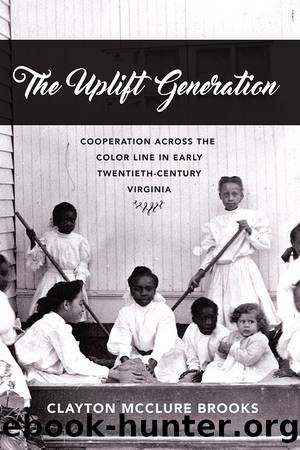The Uplift Generation by Clayton McClure Brooks

Author:Clayton McClure Brooks
Language: eng
Format: epub
Publisher: University of Virginia Press
Louis I. Jaffe. (Papers of Louis I. Jaffé, Albert and Shirley Small Special Collections Library, University of Virginia)
The African American newspapers expressed as much shock as the white dailies. The Richmond Planet questioned how such a tragedy could occur and declared that it âdid not believe that there were in this city two colored men who would have permitted a woman to be so assaulted without having made some outcry or without having offered his life to prevent such a fiendish crime in his presence.â79 Editor Mitchell, a confirmed bachelor who never entirely trusted the sensibilities of women, found it difficult to believe that any white woman in Richmond âwith her innate horror of the male members of the darker race, who would even under threat of death submit to such an indignity when there were within calling distance hundreds of white and colored men, who would have risked their lives to save her from such a disgrace.â80 He agreed that a crime had occurred but did not entirely believe the Heislersâ version of the story or that black men could have been the culprits. Black elites feared that the incident challenged their constant assurances about the irreproachable morality of the black masses. They understood that the crime could end white support of African American uplift reforms and threaten the relative peace in which the two races lived in Virginia.
After the initial frenzy, white Virginians tried to dismiss the possibility that the rapists were African American. Mrs. Heislerâs family physician, Dr. B. L. Beams, white, came forward with his story to the press. The white Richmond News Leader reported that Beams had been called the morning of the attack to treat Mrs. Heisler and, at that time, also took her statement. He confirmed that she had indeed been violated and also assured the public that it was through no fault of her own. Mrs. Heisler, Beams explained, was âa moral, honest woman though in very, humble circumstances.â81 Beams, however, offered his opinion that the house was too dark for either of the Heislers to see whether or not the attackers were actually black. Although Beamsâs statement was less than concrete evidence, the white newspapers accepted his interpretation, and fervor over the crime subsided. In the following weeks, the police continued to search for culprits with no success. With their minds eased that no crazed African American criminals were on the loose (only white ones), the white public, at least according to the newspapers, forgot about the incident.
Apart from Beamsâs statement, racial tension was diffused by white paternalists working with African American leaders, drawing upon the ties of years of interracial cooperation. Whites asked African American leaders to release statements denouncing the violence, reassuring frightened whites, and expressing their desire for racial peace. According to the Richmond Planet, âthis request was complied with although the colored people resented an imputation that any colored resident of this city would be guilty of such a crime.â The paper predicted that once âthe facts
Download
This site does not store any files on its server. We only index and link to content provided by other sites. Please contact the content providers to delete copyright contents if any and email us, we'll remove relevant links or contents immediately.
A Cultural History of Work in the Age of Empire by Victoria E. Thompson (ed.)(291)
A Rome of One's Own by Emma Southon(277)
Executive Order No. 9066: The Terrible Injustice Of 1942 by Sollace Freeman(269)
The Evidence of Things Not Seen by James Baldwin(267)
The Explorers by Amanda Bellows(246)
Respectability and Reform by Tara M. McCarthy(241)
A Wider Type of Freedom: How Struggles for Racial Justice Liberate Everyone by Daniel Martinez HoSang(220)
The Grey Eagles of Chippewa Falls by John E. Kinville(191)
Liberty's Dawn: A People's History of the Industrial Revolution by Emma Griffin(190)
Rethinking White Societies in Southern Africa by Duncan Money(188)
Letters From London by Julian Barnes(183)
The Crosswinds of Freedom by James MacGregor Burns(182)
A Troublemaker May Surprise (The Troublemaker Series Book 2) by Genta Sebastian(173)
Evolution of Slavery Through the Ages: A Comprehensive World History of Slavery by PRESS VERITY(168)
Continental Strangers by Gemunden Gerd;(160)
A Teacher's Guide to Ladies of Liberty by Cokie Roberts Amy Jurskis(159)
The Slave Ship, Memory and the Origin of Modernity by Martyn Hudson(152)
Beware the Masher by Kerry Segrave(142)
Hunger Dark Pen by Dark Pen(138)
